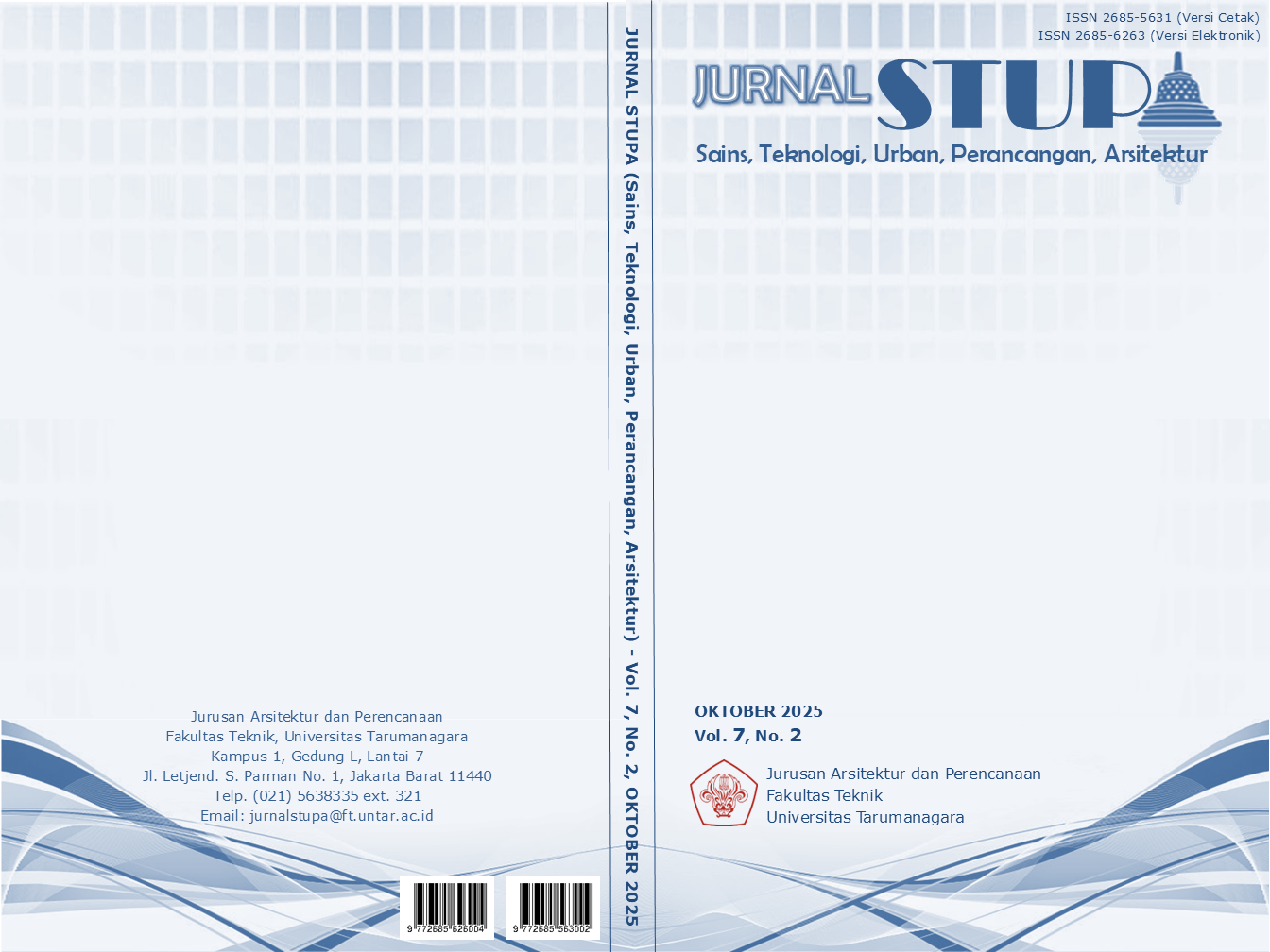LANDMARK WATER WHISPER DI WADUK RIA RIO, PULOMAS DEMI MEREGENERASI KUALITAS AIR
Isi Artikel Utama
Abstrak
The phenomenon of quality degradation in the Ria Rio Reservoir, Pulomas is an example of negligence arising from the decline in water quality and activities that are continuously ignored. The decline and passivity are the main issues faced. This requires innovative solutions to restore the water ecosystem and raise awareness of the importance of water quality. With the approach of “behavioral architecture”, this study explores the potential integration of "Water Whisper" as a monumental structure that functions dually: a visual representation of the relationship between humans-water-nature and a catalyst for water purification and education. The purpose is to analyze how the architectural design of "Water Whisper" through integrated technology, can increase the understanding and involvement of urban communities towards water quality issues in the Ria Rio Reservoir. The research method involves observation of reservoir conditions, precedent studies and literature studies on regenerative landmark design and natural water purification technology. The analysis includes the potential location of landmarks, integration of purification systems, and projections of impacts on community awareness and behavior. The spatial novelty lies in the application of the interactive landmark concept as a solution to increase awareness and action on the decline in water quality in urban environments. The expected outcome is that the effective “Water Whisper” model not only raises awareness in the Ria Rio Reservoir, but can also be replicated to address similar issues in other urban areas.
Keywords: behavioral architecture; landmark; regenerative; water quality
Abstrak
Fenomena degradasi kualitas di area Waduk Ria Rio, Pulomas merupakan contoh kelalaian yang timbul dari penurunan kualitas air dan aktivitas yang terus dibiarkan. Berkurangnya serta sikap pasif menjadi isu utama yang dihadapi. Masalah ini memerlukan solusi inovatif untuk memulihkan ekosistem air dan meningkatkan kesadaran akan pentingnya kualitas air. Dengan pendekatan arsitektur perilaku, penelitian ini mengeksplorasi potensi integrasi "Water Whisper" sebagai struktur monumental yang berfungsi ganda: representasi visual keterkaitan manusia-air-alam dan katalisator pemurnian air serta edukasi. Tujuan penelitian adalah menganalisis bagaimana desain arsitektur "Water Whisper", melalui teknologi terintegrasi, dapat meningkatkan pemahaman dan keterlibatan masyarakat urban terhadap isu kualitas air di Waduk Ria Rio. Metode penelitian melibatkan observasi kondisi waduk, studi preseden dan literatur desain landmark regeneratif serta teknologi pemurnian air alami. Analisis meliputi potensi lokasi landmark, integrasi sistem pemurnian, dan proyeksi dampak terhadap kesadaran serta perilaku masyarakat. Kebaruan keruangan terletak pada penerapan konsep landmark interaktif sebagai solusi peningkatan kesadaran dan tindakan terhadap penurunan kualitas air di lingkungan urban. Hasil yang diharapkan adalah model "Water Whisper" yang efektif tidak hanya meningkatkan kesadaran di Waduk Ria Rio, namun juga dapat direplikasi untuk mengatasi masalah serupa di wilayah perkotaan lainnya.
Rincian Artikel

Artikel ini berlisensiCreative Commons Attribution-NonCommercial-ShareAlike 4.0 International License.
This work is licensed under a Jurnal Sains, Teknologi, Urban, Perancangan, Arsitektur/ STUPA Creative Commons Attribution-NonCommercial-ShareAlike 4.0 International LicenseReferensi
Alyka, F., Puspitasari, N., & Umam, S. (2022). Pengelolaan Kualitas Lingkungan Analisa Kualitas Air pada Waduk Ria Rio. Universitas Indonesia, Departemen Teknik Sipil dan Lingkungan. Depok: Universitas Indonesia.
Baper, S. Y., Khayat, M., & Hasan, L. (2020). Towards regenerative architecture: Material effectiveness. International Journal of Technology, 11(4), 722-731.
Konietzko, J., Das, A., & Bocken, N. (2023). Towards regenerative business models: A necessary shift?. Sustainable Production and Consumption, 38, 372-388.
Pemerintah Pusat. (2021). Peraturan Pemerintah (PP) Nomor 22 Tahun 2021 tentang Penyelenggaraan Perlindungan dan Pengelolaan Lingkungan Hidup. Jakarta, Indonesia: Pemerintah Pusat. Retrieved from jdih.setkab.go.id
Plaves, Y., Jacobs, P., & Jonescu, E. (2023). Defining regenerative design: The foundation to systemic understanding, adoption, and practice. Adoption, and Practice (April 20, 2023).
Yudo, S., & Said , N. I. (2001, Mei). Masalah Pencemaran Air Di Jakarta, Sumber Dan Alternatif Penanggulangannya. Jurnal Teknologi Lingkungan, 2, 199-206. doi:10.29122/jtl.v2i2.214



